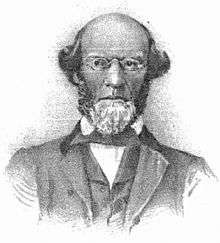John Beach
| John Beach | |
|---|---|
| Born |
January 1, 1812 Massachusetts, United States |
| Died |
August 31, 1874 (aged 62) Agency City, Iowa |
| Buried at | Chief Wapello's Memorial Park, Wapello County, Iowa |
| Allegiance |
Union |
| Service/branch | Union Army |
| Years of service | 1828–1838; 1861–1866 |
| Rank |
|
| Unit | 1st Infantry Regiment |
| Battles/wars |
Black Hawk War American Civil War |
| Other work | Farmer, merchant and writer |
Major John Beach (January 1, 1812 – August 31, 1874) was a United States Army officer during the Black Hawk and American Civil War as well as the last U.S. Indian Agent to the Sac and Fox tribes. A son-in-law to General Joseph Street, Beach succeeded him as agent to the Sac and Fox upon his death and eventually hosted the week-long council that resulted in the signing of the treaty for the purchase of much of Iowa from the Sac and Fox Indians in October 1842.
Biography

Born in Massachusetts to William Beach and Lucy Tucker,[1] John Beach enlisted in the U.S. Army during his late teens and graduated from the West Point Military Academy on July 1, 1832. He was commissioned as a brevet 2nd lieutenant served on the frontier with the Infantry Regiment, assigned to Fort Armstrong and Fort Crawford during the 1830s. In 1836, he took command of the Fort Armstrong garrison after its commanding officer Lt. Col. William Davenport ordered an evacuation and led a march to Fort Snelling in Hennepin County, Minnesota. Beach would remain at Fort Armstrong until being assigned elsewhere in November.[2] During his last year with the army, he was involved in recruitment efforts before his resignation on June 30, 1838. Beach later married Lucy Frances Street, the daughter of General Joseph Street.[1]
Two years later, he succeeded his father-in-law General Joseph Street as U.S. Indian Agent to the Sac and Fox tribes following Street's death. He continued his predecessor's work in establishing farming and education to the Raccoon River Agency reservation, although he was ultimately unsuccessful in the former goal. He also opposed settlers sqatting on reservation land as, in 1841, a force of dragoons under Lieutenant C.F. Ruff removed James Jordan and other settlers illegally living on the reservation. They had previously ignored Beach's order to leave and, after allowing them to gather their possessions, Ruff ordered his men to burn their homes.[3] On October 11, 1842, he presided over the signing of a treaty which allowed the federal government to purchase much of Iowa from the Sac and Fox. He remained at the agency until 1847 where he resided in the area as a local farmer and merchant. Beach reenlisted during the American Civil War, however he involved in the training and drilling of recruits as his hearing loss disqualified him from the field.
Returning to Agency City following the war, he became a writer and historian in his later years. He died on August 31, 1874, at age 62 and buried at Chief Wapello's Memorial Park.[4] A series of articles he had written on the early history of the various tribes he lived with during his career were published posthumously in the Agency Independent in the months following his death.[5] His writings on the history of the Fox and Sac, as well as the fur trade on the Des Moines River, were later included in the History of Wapello County (1878).[6]
References
- 1 2 Street, Mary A. The Street Genealogy. Exeter, New Hampshire: John Templeton, 1895. (pg. 279)
- ↑ Annual Reports of the Secretary of War. Vol. III. Washington, D.C.: Government Printing Office, 1877. (pg. 48)
- ↑ Pelzer, Louis. Marches of the Dragoons in the Mississippi Valley. Iowa City: State Historical Society of Iowa, 1917. (pg. 90)
- ↑ Cullum, George G. Biographical Register of the Officers and Graduates of the U.S. Military Academy at West Point, N.Y. from its Establishment in 1802 to 1890 with the Early History of the United States Military Academy. Vol. 1. Boston and New York: Houghton, Mifflin & Co., 1891. (pg. 526)
- ↑ The History of Lee County, Iowa. Chicago: Western Historical Company, 1879. (pg. 349)
- ↑ Thwaites, Reuben Gold, ed. Collections of the State Historical Society of Wisconsin. Vol. XV. Madison: Democrat Printing Co., 1900. (pg. 154)
Further reading
- Berthrong, Donald J. "John Beach and the Removal of the Sauk and Fox from Iowa". Iowa Journal of History and Politics. 54 (October 1956): 318-20.
- Gallagher, Ruth A. "Indian Agents in Iowa: Agents among the Sauk and Fox". Iowa Journal of History and Politics. 14 (July 1916): 364-365.
- Green, Michael D. "The Sac-Fox Annuity Crisis of 1840 in Iowa Territory". Arizona and the West. 16 (Summer 1974): 141-150.
External links
- "John Beach". Find a Grave. Retrieved 2008-11-01.